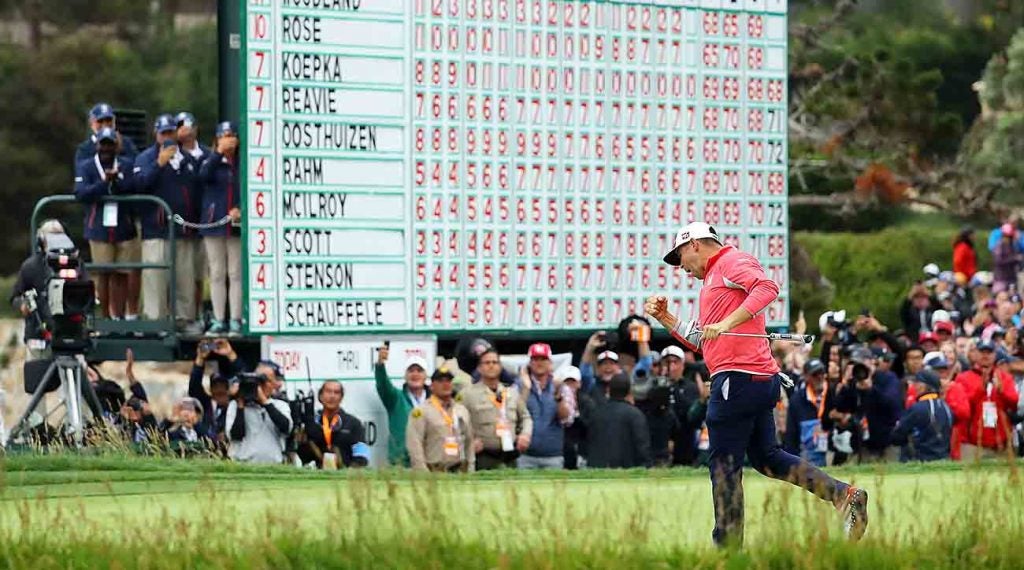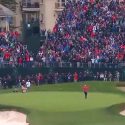PEBBLE BEACH, Calif. — The U.S. Open favors ballplayers. Jack Nicklaus (four wins) was a ballplayer. Hale Irwin (three wins) was a ballplayer. Brooks Koepka (two) is ballplayer. Gary Woodland of Topeka, Kansas, our new national champion in men’s golf, with a Wilson baseball hat on his large head and athletic tape on two of his beefy fingers, is a ballplayer’s ballplayer. Viewed that way, his win here, his salmon windbreaker offering about the only color on a gray and dank Sunday, is nothing like a surprise. He’s out of the mold. The surprise is that he did what very few ever do: playing for the first time in the final twosome on the final day of a major, he never showed a hint of flinch. His play was as solid as his physique. Talk about rock-steady. Yes, he made two bogeys. In response to these hiccups his broad, impassive face seemed to say, No big whoop. What-me-worry is a beautiful thing.

Golf’s cognoscenti have known for a decade that Gary Woodland had all the tools. That’s why Mark Steinberg, agent to the stars, signed him, one basketball player recruiting another. But tools alone are not enough. That was the lesson of this Open win.
In victory, Woodland spoke of how he has learned to manage his talent, praising particularly his former coach (Butch Harmon) and his current coach (Pete Cowen). He gave a shoutout to his caddie, Brennan Little, who caddied for Mike Weir when Weir won the 2003 Masters. He sang the praises of his first coach, his father, and you can just tell this man, at the scene on Father’s Day but at a safe distance, is the kind of made-in-America man who made this country great.
Said Woodland, “I wouldn’t be where I am without my dad. My dad worked nights growing up [and he] never forced me to do anything. But if I did it, if I decided to go play catch or basketball, he was hard on me. You had to do it the right way.”
In the Woodland home, you can just tell, there was a Zero Tolerance policy for wussy behavior.

All through his career, Woodland has shown a generous spirit. At the Phoenix Open in January, Woodland’s encouragement of and exchanges with a Special Olympics athlete named Amy Bockerstette showed the PGA Tour at its very best. One Tour veteran said that in that moment Woodland did more to show his real self than he could in a decade of over-the-top, trying-too-hard social media posts. He described his friendship with Amy in his winner’s press conference. He also said a series of sentences that high school and college coaches could put on their bulletin boards and leave there forever:
“I think the big deal is to enjoy the pressure. Obviously, it’s an uncomfortable situation, leading in a major championship after 36 holes, after 54 holes. But I kept telling myself, ‘Enjoy this moment. Enjoy the pressure. Enjoy the stress. Enjoy being uncomfortable. Don’t shy away from it, embrace it.’ And that’s what I really tried to do, embrace that pressure all day. And I think that helped me stay a little more calm.”
Three quick things about that statement. First of all, it’s deeply articulate, as is he. Also, it shows a thinking and aware person. But it should be noted that saying it and doing it are two different things. On Sunday, Woodland did it. He executed.
“I think from a mental standpoint I was as good as I’ve ever been,” Woodland said. “I never let myself get ahead of myself. I never thought about what would happen if I won, what comes with it. I was proud of myself to stay in it, to slow down a little bit, to slow my thinking down and really focus on what I was doing and not let my mind wander at all.”
Wow!

People don’t say “Gary.” He’s not Tiger or Phil. He’s not Jordan or Justin or DJ or Rory or Rickie. He’s not glamorous and he is not — PTL! — a brand. Gary Woodland is a guy, a polite, do-the-work, straight-forward golf-pro with a sensitive side, a second-generation smasher whose short game is catching up with his long game. He can get better.
But one thing that was perfect was the 30-yard second-shot chip he played on the par-3 17th, from the green, on Sunday. That shot will go down as one of the Top 100 Clutch U.S. Open shots ever. We say that in part because had it gone wrong — it could have gone horribly wrong — it could have led to a career-defining double or worse. After all, it’s not like Woodland had had any experience playing delicate shots with golf’s most important title hanging in the balance. It also belongs in the Top 100 because he flat-out nailed it: a low, heel-up, toe-down, no-divot chip-pitch that left him with a tap-in par. It was the shot that won him the title. His playing partner, Justin Rose, the 2013 U.S. Open winner, gave him a fist bump. They both knew what it meant. It meant that Woodland could make a bogey on the last and still win. Instead, he made a birdie.
His parents were on hand. His wife, expecting twins, was at home with their young son, not yet two. This is a family that has known the joy and heartbreak of starting a family.
“Being a father puts life in perspective,” Woodland said. “My whole life it’s all been about trying to win. And now I’m trying to make a better life for my son than I’ve had.”
The American Dream, Part II.
Gary Woodland, winner of your national championship. Ballplayer, father, son, husband, golfer, the hat low, the game-face on.
Michael Bamberger may be reached at Michael_Bamberger@golf.com
ADVERTISEMENT






